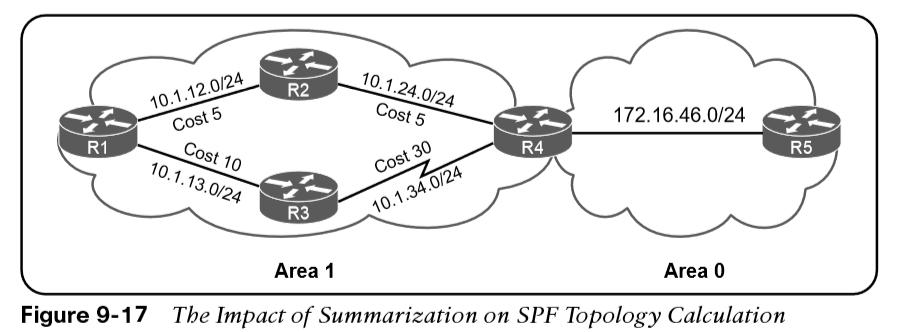
OSPF Routes Summarization
how network summarization works with OSPF.
- Route scalability is a large factor for the IGP routing protocols used by service providers because there can be thousands of routers running in a network.
- Splitting up an OSPF routing domain into multiple areas reduces the size of the LSDB for each area.
- While the number of routers and networks remains the same within the OSPF routing domain, the detailed type 1 and type 2 LSAs are exchanged for simpler type 3 LSAs.
Summarization of Routes Example
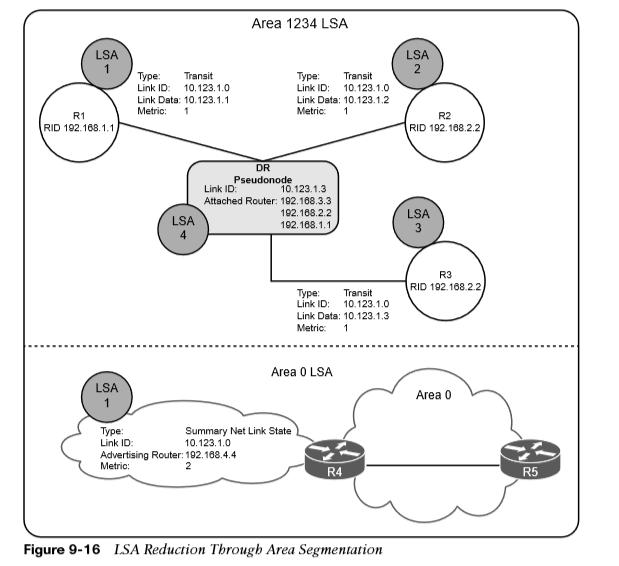
- Referencing our topology for LSAs, in Figure 9-16 for Area 1234, there are three type 1 LSAs and one type 2 LSA for the 10.123.1.0/24 network.
- Those four LSAs become one type 3 LSA outside Area 1234.
- This illustrates the reduction of LSAs through area segmentation for the 10.123.1.0/24 network.
Summarization Fundamentals
- Another method of shrinking the LSDB involves summarizing network prefixes. An OSPF area needs to accommodate the smallest and slowest router in that area.
- Summarization of routes also helps SPF calculations run faster. Because all routers within an area must maintain an identical copy of the LSDB, summarization occurs between areas on the ABRs.
- Summarization can eliminate the SPF calculation outside the area for the summarized prefixes because the smaller prefixes are hidden.
Figure 9-17 provides a simple network topology where the serial link between R3 and R4 adds to the path metric, and all traffic uses the other path to reach the 172.16.46.0/24 network. If the 10.1.12.0/24 link fails, all routers in Area 1 have to run SPF calculations. R4 identifies that the 10.1.13.0/24 and 10.1.34.0/24 networks will change their next hop through the serial link. Both of the type 3 LSAs for these networks need to be updated with new path metrics and advertised into Area 0. The routers in Area 0 run an SPF calculation only on those two prefixes.  Figure 9-18 shows the networks in Area 1 being summarized at the ABR into the aggregate 10.1.0.0/18 prefix. If the 10.1.12.0/24 link fails, all the routers in Area 1 still run the SPF calculation, but routers in Area 0 are not impacted because the 10.1.13.0/24 and 10.1.34.0/24 networks are not known outside Area 1.
Figure 9-18 shows the networks in Area 1 being summarized at the ABR into the aggregate 10.1.0.0/18 prefix. If the 10.1.12.0/24 link fails, all the routers in Area 1 still run the SPF calculation, but routers in Area 0 are not impacted because the 10.1.13.0/24 and 10.1.34.0/24 networks are not known outside Area 1. 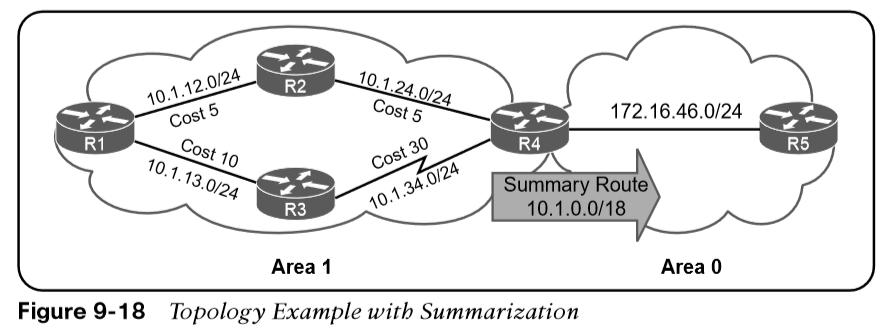
Interarea Summarization
- Interarea summarization reduces the number of type 3 LSAs that an ABR advertises into an area when it receives type 1 LSAs.
- The network summarization range is associated with a specific source area for type 1 LSAs.
- When a type 1 LSA within the summarization range reaches the ABR from the source area, the ABR creates a type 3 LSA for the summarized network range.
- The ABR suppresses the more specific type 3 LSAs, thereby preventing the generation of the subordinate route’s type 3 LSAs. Interarea summarization does not impact the type 1 LSAs in the source area.
Summarization works only on type 1 LSAs and is normally configured so that summarization occurs as routes enter the backbone from nonbackbone areas. Figure 9-19 shows 15 type 1 LSAs (172.16.1.0/24 through 172.16.15.0/24) being summarized into one type 3 LSA (the 172.16.0.0/20 network). 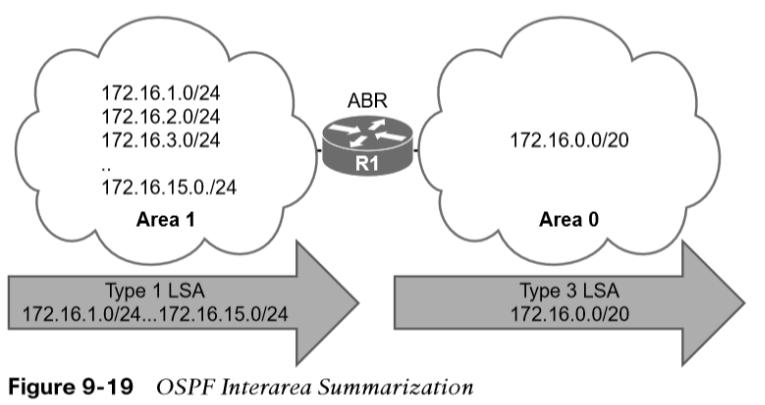
Summarization Metrics
The default metric for the summary LSA is the smallest metric associated with an LSA. However, it can be set as part of the configuration. OSPF behaves identically to Enhanced Interior Gateway Routing Protocol (EIGRP) and checks every prefix within the summarization range when a matching type 1 LSA is added or removed. If a lower metric is available, the summary LSA is advertised with the newer metric; if the lowest metric is removed, a newer and higher metric is identified, and a new summary LSA is advertised with the higher metric. In Figure 9-20, R1 summarizes three prefixes with various path costs. 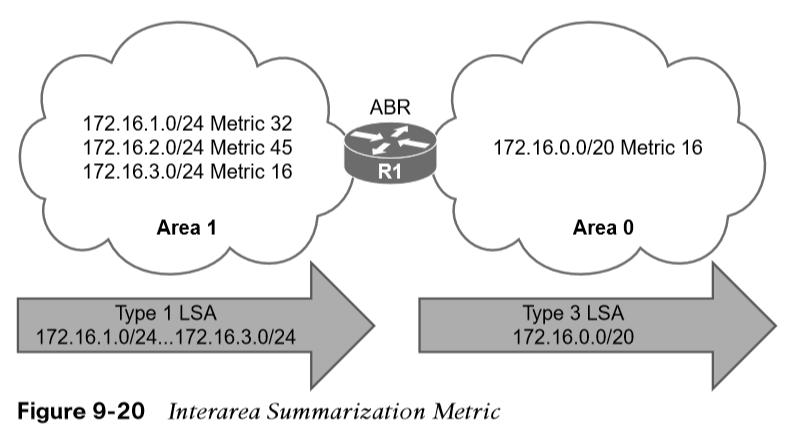
Configuration of Interarea Metrics
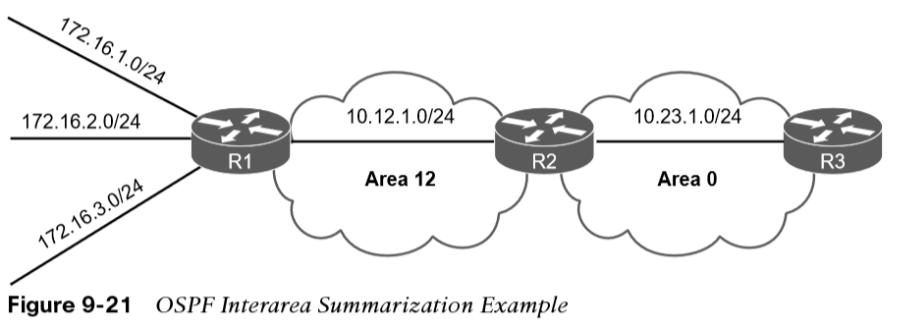
- To define the summarization range and associated area, use the command area area-id range network subnet-mask [advertise | not-advertise] [cost metric] under the OSPF process on the ABR.
- The default behavior is to advertise the summary prefix, so the keyword advertise is not necessary.
- Appending the cost metric keyword to the command statically sets the metric on the summary route.
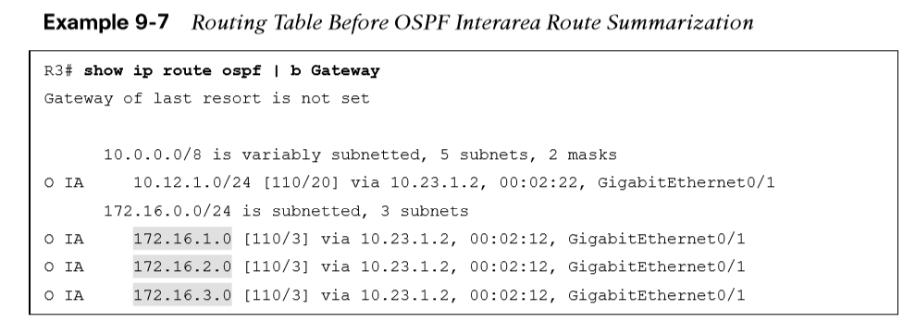 Example 9-7 displays the routing table on R3 before summarization. Notice that the 172.16.1.0/24, 172.16.2.0/24, and 172.16.3.0/24 networks are all present.
Example 9-7 displays the routing table on R3 before summarization. Notice that the 172.16.1.0/24, 172.16.2.0/24, and 172.16.3.0/24 networks are all present.
Example 9-8 provides R2’s configuration for interarea summarization into an aggregate route of 172.16.0.0/16. A static cost of 45 is added to the summary route to reduce CPU load if any of the three networks flap. 
 Example 9-9 displays R3’s routing table for verification that the smaller routes were suppressed while the summary route was aggregated. Notice that the path metric is 46, whereas previously the metric for the 172.16.1.0/24 network was 3. The ABR performing interarea summarization installs a discard route. The discard route is a route to the Null0 interface that matches the summarized network range. Discard routes prevent routing loops where portions of the summarized network range do not have a more specific route in the RIB. The AD for the OSPF summary discard route for internal networks is 110, and it is 254 for external networks.
Example 9-9 displays R3’s routing table for verification that the smaller routes were suppressed while the summary route was aggregated. Notice that the path metric is 46, whereas previously the metric for the 172.16.1.0/24 network was 3. The ABR performing interarea summarization installs a discard route. The discard route is a route to the Null0 interface that matches the summarized network range. Discard routes prevent routing loops where portions of the summarized network range do not have a more specific route in the RIB. The AD for the OSPF summary discard route for internal networks is 110, and it is 254 for external networks.  Other useful information:
Other useful information: